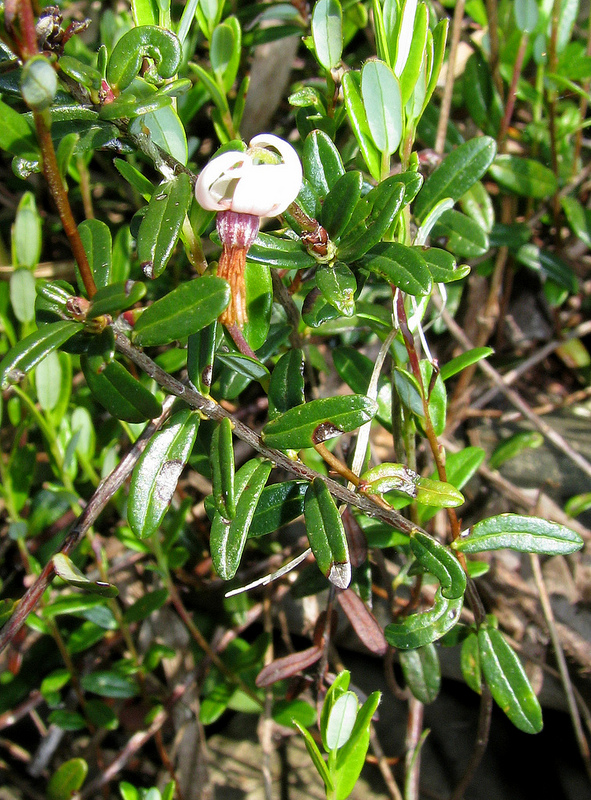Map Snapshot


18 Records
Relationships
Host plant for Bog Copper.
Seasonality Snapshot
Source: Wikipedia
| Vaccinium oxycoccos | |
|---|---|

| |
| Fruit on a bed of Sphagnum rubellum | |
| Scientific classification | |
| Kingdom: | Plantae |
| Clade: | Tracheophytes |
| Clade: | Angiosperms |
| Clade: | Eudicots |
| Clade: | Asterids |
| Order: | Ericales |
| Family: | Ericaceae |
| Genus: | Vaccinium |
| Subgenus: | Vaccinium subg. Oxycoccus |
| Species: | V. oxycoccos
|
| Binomial name | |
| Vaccinium oxycoccos L. 1753
| |
| Synonyms[3][4] | |
|
Synonymy
| |
Vaccinium oxycoccos is a species of flowering plant in the heath family. It is known as small cranberry, marshberry, bog cranberry, swamp cranberry,[5] or, particularly in Britain, just cranberry.[6] It is widespread throughout the cool temperate northern hemisphere, including northern Europe, northern Asia and northern North America.[5]
Description
[edit]This cranberry is a small, prostrate shrub with vine-like stems that root at the nodes. The leaves are leathery and lance-shaped, up to 1 cm (0.39 in) long.[5] Flowers arise on nodding stalks a few centimeters tall. The corolla is white or pink and flexed backward away from the center of the flower. The fruit is a red berry which has spots when young. It measures up to 1.2 cm (0.47 in) wide.[4][7] The plant forms associations with mycorrhizae. It mainly reproduces vegetatively.[5]
Distribution and habitat
[edit]Vaccinium oxycoccos is a widespread and common species occurring broadly across cooler climates in the temperate northern hemisphere.[5][2][8][9][10] It is an indicator of moist to wet soils which are low in nitrogen and have a high water table. It is an indicator of coniferous swamps. It grows in bogs and fens in moist forest habitat. It grows on peat which may be saturated most of the time. The soil in bogs is acidic and low in nutrients. The plant's mycorrhizae help it obtain nutrients in this situation. Fens have somewhat less acidic soil, which is also higher in nutrients. The plant can often be found growing on hummocks of Sphagnum mosses.
Ecology
[edit]In North America, other species found in this forest understory habitat include leatherleaf (Chamaedaphne calyculata), bog rosemary (Andromeda glaucophylla), bog laurel (Kalmia polifolia), pitcher plant (Sarracenia purpurea), Labrador tea (Rhododendron groenlandicum), cloudberry (Rubus chamaemorus), rhodora (Rhododendron canadense), glossy buckthorn (Rhamnus frangula), sundew (Drosera spp.), cottonsedge (Eriophorum virginatum and E. angustifolium), and species of sedge and lichen. The plant easily colonizes bog habitat that has recently burned. It survives fire with its underground rhizomes.[4][5]
Uses
[edit]The berries of Vaccinium oxycoccos are edible[11] and have been used both as a medicine and as a food by various Native American communities. Some Iñupiat cook the cranberry with fish eggs and blubber.[12][13]
References
[edit]- ^ Maiz-Tome, L. (2016). "Vaccinium oxycoccos". IUCN Red List of Threatened Species. 2016: e.T64326221A67731197. doi:10.2305/IUCN.UK.2016-1.RLTS.T64326221A67731197.en.
- ^ a b "Vaccinium oxycoccos". NatureServe.
- ^ "Vaccinium oxycoccos". World Checklist of Selected Plant Families. Royal Botanic Gardens, Kew – via The Plant List. Note that this website has been superseded by World Flora Online
- ^ a b c Fang, Ruizheng; Steven, Peter F. "Vaccinium oxycoccus". Flora of China. Vol. 14 – via eFloras.org, Missouri Botanical Garden, St. Louis, MO & Harvard University Herbaria, Cambridge, MA.
- ^ a b c d e f Matthews, Robin F. (1992). "Vaccinium oxycoccos". Fire Effects Information System (FEIS). US Department of Agriculture (USDA), Forest Service (USFS), Rocky Mountain Research Station, Fire Sciences Laboratory.
- ^ Stace, Clive (2010). New Flora of the British Isles (3rd ed.). Cambridge, UK: Cambridge University Press. p. 512. ISBN 978-0-521-70772-5.
- ^ Vander Kloet, Sam P. (2009). "Vaccinium oxycoccos". In Flora of North America Editorial Committee (ed.). Flora of North America North of Mexico (FNA). Vol. 8. New York and Oxford: Oxford University Press – via eFloras.org, Missouri Botanical Garden, St. Louis, MO & Harvard University Herbaria, Cambridge, MA.
- ^ "Vaccinium oxycoccos". County-level distribution map from the North American Plant Atlas (NAPA). Biota of North America Program (BONAP). 2014.
- ^ "Vaccinium oxycoccos L." Tela Botanica (in French). Photos, description, French distribution map.
- ^ "Vaccinium oxycoccos L." Schede di botanica (in Italian). Photos and European distribution map.
- ^ Benoliel, Doug (2011). Northwest Foraging: The Classic Guide to Edible Plants of the Pacific Northwest (Rev. and updated ed.). Seattle, WA: Skipstone. pp. 47–48. ISBN 978-1-59485-366-1. OCLC 668195076.
- ^ Jones, Anore (1983). "Nauriat niginaqtuat (Plants that we eat)". Maniilaq Association Traditional Nutrition Program. Kotzebue, Alaska: 104. According to the brief annotation in Anonymous (2003).
- ^ Anonymous (2003). "Vaccinium oxycoccos L." Native American Ethnobotany. Dearborn, MI: University of Michigan-Dearborn. Retrieved 24 May 2023.
External links
[edit]- Washington Burke Museum, University of Washington
- illustration from Flora of China Illustrations vol. 14, fig. 688, 2-5
- "Vaccinium oxycoccos". Plants for a Future.
- Go Botany, New England Wildflower Society
- Luontoportti, NatureGate, Isokarpalo (Vaccinium oxycoccos) description, photos, ecological and culinary information, link to distribution map for Finland
- Native Plant Database profile, Lady Bird Johnson Wildflower Center, University of Texas at Austin
- Ontario Wildflowers




